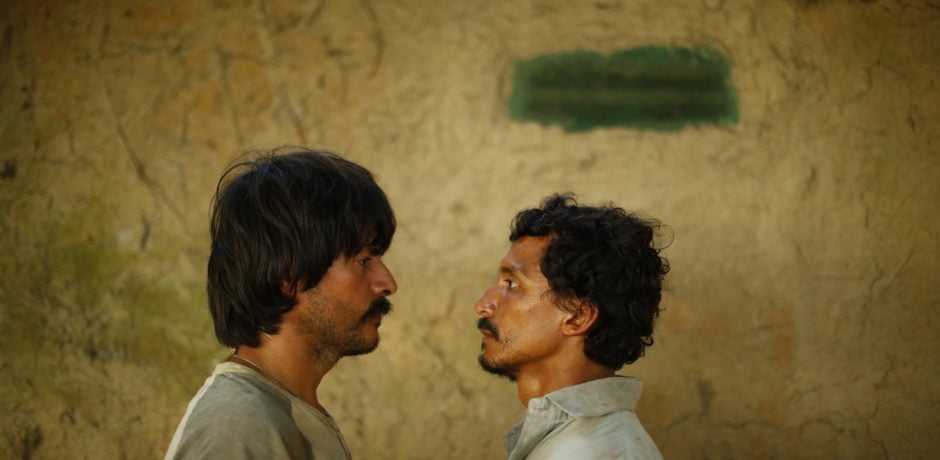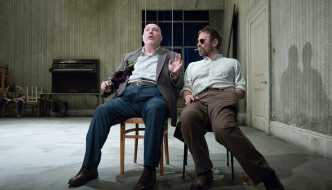
Venezuelan Roberto Calzadilla makes his directorial debut with El Amparo, the tale of a real-life thirty year-old tragedy which left a small community fighting to protect the honour of twelve of its men, framed as anti-government guerillas by the military commanders who had them gunned down. By treading carefully between all-out drama and historical recreation, Calzadilla creates a gritty, contemplative piece of cinema which feels true.
The film opens by introducing us to the scorching and impoverished, but still friendly and resilient, titular village of El Amparo, sitting on the border between Venezuela and Colombia. Although the men here are the breadwinners— when they’re not sipping rum from the bottle—it is the women who keep the place on its feet. The early scenes introduce Pinilla (Vicente Quintero) and Chumba (Giovanni García), as well as their partners, who lead a group of fourteen jovial, rum-fuelled men and boys on a fishing expedition.
As the group—complete with singing drunk—arrives at their destination, the mood takes a sudden downturn. Although no blood is spilt on screen, the idea that something has gone horribly wrong is planted through the creative use of news footage and El Amparo’s villagers receiving crackling radio bulletins of a confrontation between the military and supposed guerrilla fighters attacking an oil refinery up-river.
News of the shootings spreads, and tempers flare the following morning when local police sheriff Mendieta (Vicente Peña) returns with Chumba and Pinilla—the only survivors of the group. It is here that the film really comes in to its own with the gut-wrenching portrayal of the moment the women of El Amparo realise their husbands, sons, fathers and brothers have been put to the slaughter.
From then on, the El Amparo introduced at the beginning of the film is no more. As Pinilla and Chumba spend most of the film’s second half locked in a dismal prison cell—themselves battling with giving in to the military’s version of events—outside the community breaks down, with families and friends divided by dubious offers of money and security from various military and political brokers.
Calzadilla extracts skilled and moving performances from his actors as the plot profoundly reflects on the shock, outrage and grief a community must face when confronted with such injustice. The looming question of who controls history—the government with power and money, or the community with fortitude and, more importantly, the truth—is masterfully conveyed through heated discussions both in and out of the prison cell. “You cannot eat the truth,” argues one villager, as the women wrangle with accepting the bribes they are offered now the men are no longer around to provide.
Although the film unashamedly comes down on the side of the villagers (as did, in the end, human rights courts), who from the off protest the innocence of the murdered men and contest the guerrilla label applied by the Venezuelan authorities, it triumphs by avoiding making heroes of anyone. There are no winners here. While the government doesn’t get its way, there is also no victory for the people of El Amparo. In real life it took almost a decade for any court to side with them and demand reparations from the government.
Ultimately, though, El Amparo’s true-to-life charm will probably also prove to be its downfall. Calzadilla resists any temptation to over-dramatise events—there are no shots fired throughout the entire film—instead relying on emotion, empathy and reflection to grip the audience. But it does begin to trudge, in parts, and there are scenes where you feel this conscious decision does mean some glimpses of simmering tension end up petering out and feeling a little flat. As a result it seems the film will be a hard sell outside of Latin American markets (the screening at HOME Manchester is barely half full).
However, that should not detract from the importance of Calzadilla’s film. The story of El Amparo—of brutal murder, cover-ups and corruption from those lucky enough to be in charge—is one which will be all too familiar for anyone with even a minor interest in history, and these are the stories which of course always need to be talked about. Today, in a world still riddled with similar injustices—and with the two men still fighting for their case to be moved from Venezuela’s military courts to the civil ones—it is imperative we continue to tell them.
Filed under: Film, TV & Tech
Tagged with: ¡Viva! Spanish and Latin American Festival, El Amparo, HOME, homemcr, latin america, Roberto Calzadilla, South America, Venezuela



Comments